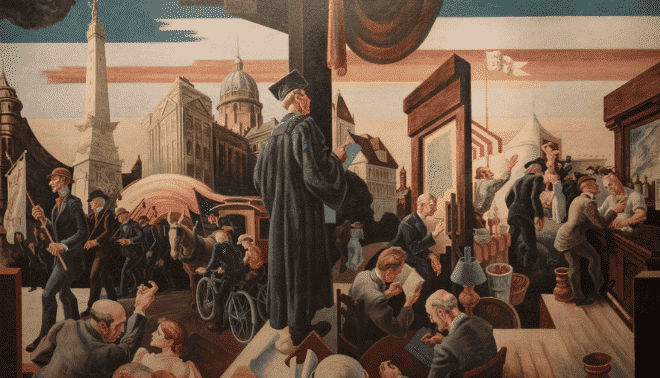Sign up for the Family Tree Newsletter! Plus, you’ll receive our 10 Essential Genealogy Research Forms PDF as a special thank you.
Get Your Free Genealogy Forms
"*" indicates required fields
When you vote this Election Day, whether you lean to donkeys or elephants, you’ll assume the ballot will be prepared by election officials, you’ll make a mark or punch a hole or pull a lever, and your ballot will be secret.
But these practices would surprise most of our ancestors. The first election fitting those three criteria was only 150 years ago, in Australia, and didn’t happen in the US until 30 years after that.
Ostrakas, ballots and voice votes
The world’s first votes were cast as early as 508 BC in ancient Athens. Officials were chosen by lottery, and voting was negative: Politicians’ names were inscribed on pieces of broken pots—ostrakas, the root of our word ostracize—and if any received more than 6,000 votes, the “winner” was exiled for 10 years.
Positive voting wouldn’t catch on until 13th-century Venice, which elected a 40-member Great Council. Back when, citizens cast their votes with colored balls. The word ballot derives from the Italian ballota for “ball.”
One alternative was voice voting. Voters would take an oath—much of early America lacked voter registration—and then announce their votes. Election clerks would record these voice votes, a system that persisted in some locales into the 1860s.
Paper ballots
In the United States, paper ballots were first used in 1629, to select a church pastor in Salem, Mass. At first, voters supplid scraps of paper. As political parties grew, however, partisans began printing ballots to make supporting their candidates easier. You could depart from the party line by crossing out a name and writing in the opponent—although tightly printed, barely legible partisan ballots made this almost impossible by the 1880s.
In urban areas, ballots were printed on colored paper, so poll watchers could easily tell how people voted (in a transparent ballot box, meant to avoid stuffing).
Secret voting
William Robinson Boothby (1829-1903), an Australian electoral commissioner and sheriff, pioneered officially preprinted ballots cast in secret. In 1856, the Australian ballot required voters to strike through the names of unwanted candidates. But in 1858, ballots instructed voters to make “a cross within the square opposite the name [of] the candidate for whom he intends to vote.” The modern ballot was born—and cast.
Boothby’s ballot caught on slowly in the United States, but the disputed presidential election of 1876 gave impetus to reform. In 1892, Grover Cleveland became the first president elected in part with Australian ballots. The old party-printed ballots persisted in pockets of America, however: As late as 1940, Delaware and South Carolina still used partisan ballots.
Levers and scanners
Newfangled technology began to replace paper ballots even as the Australian system spread. First came the lever voting machine, whose clicking and whooshing remains the sound of democracy for many Americans who came of age in the 20th century. The Myers Automated Booth was designed to “protect mechanically the voter from rascaldom, and make the process of casting the ballot perfectly plain, simple and secret.” First used in Lockport, NY, in 1892, lever voting machines were standard in every major US city by 1930.
Lever machines went out of production in 1982, however, and by 2004 represented only 14 percent of American voting. Several technologies supplanted them, beginning with the “mark-sense scanning” originally used for standardized testing. In 1962, Kern City, Calif., became the first to use optical mark-sense ballots; the system to scan them weighed 15,000 pounds. By 2004, optical scan ballots accounted for 35 percent of US votes, more than any other system.
How the chad got its start
The punched-card machine was patented by Herman Hollerith in 1889, but wasn’t applied to voting for decades. The Harris Votomatic company patented a punch-card voting machine in 1965. Its descendant was involved in the 2000 Florida “hanging chad” controversy; punched-card votes dropped from 31 percent to 13 percent of US ballots by 2004.
Direct recording
The latest wrinkle in voting technology, with nearly 30 percent of 2004 ballots, is the direct recording machine—an electronic twist on the old lever machine. The first direct-recording machine, the Video Voter, was used in Illinois elections in 1975.
Our ancestors would be amazed to see us voting by computer, with official ballots cast affirmatively and in secret. But not every change represents progress, of course: You never heard of the Athenians having problems with “hanging ostrakas.”
Timeline
1789: Constitution empowers states to set voting rights; most enfranchise only white male property owners age 21 and older
1830s: Property requirements begin to ease
1848: Women’s Rights Convention in Seneca Falls, NY, launches suffrage movement
1870: 15th Amendment extends voting rights to African-American men
1890: Wyoming allows women to vote
1920: 19th Amendment grants women’s suffrage
1940: American Indians are recognized as citizens, although not all are allowed to vote until 1947
1964: 24th Amendment prohibits poll taxes
1965: Voting Rights Act protects minority voters
1971: 26th Amendment lowers voting age to 18




